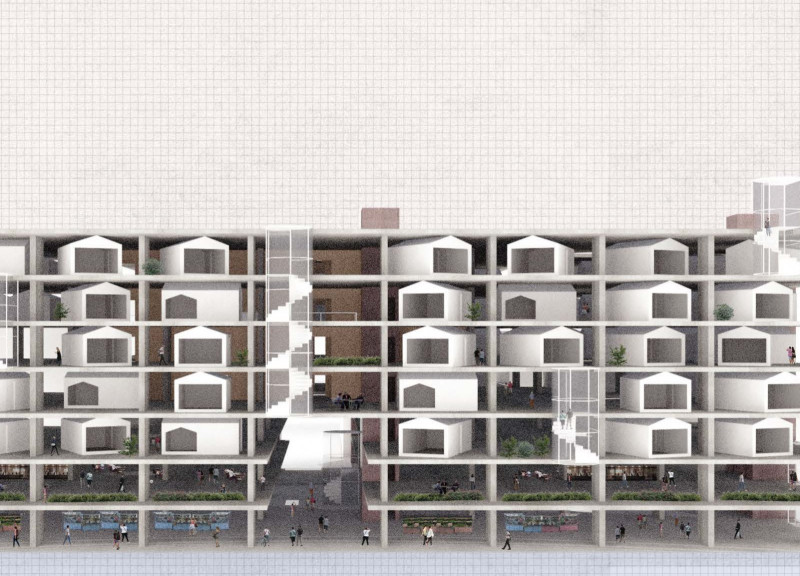5 key facts about this project
The architecture of Carpark Living fundamentally encapsulates the dual purpose of offering affordable housing while fostering social interaction among its inhabitants. The overall design emphasizes coexistence and collaboration by integrating living and working sections within a single framework. Each residential unit is meticulously designed to accommodate individuals while ensuring that communal spaces are easily accessible and promote interaction.
One of the critical aspects of this project is its spatial organization. The residential modules are arranged in a circular formation around shared communal areas, creating a sense of community while maintaining personal privacy. This layout not only allows for efficient use of space but also facilitates natural light and encourages ventilation, making for a more pleasant living environment. The clustering of units promotes ease of movement and interaction, emphasizing a lifestyle centered on connection rather than isolation.
The communal roofscape is among the defining features of Carpark Living. This area serves multiple purposes, functioning as an outdoor amenity space for recreation, relaxation, and social gatherings. By positioning a rooftop space that allows for both private and communal activities, the design caters to the diverse needs of residents. It offers a unique opportunity for outdoor experiences in an urban setting, fostering a sense of belonging and community.
The materiality of Carpark Living is carefully selected, with concrete forming the main structural framework, ensuring durability and resilience. Wooden elements within the interior evoke warmth and a sense of home, counteracting the starkness often associated with urban living environments. Glass features are strategically used to create transparent walls in communal areas, which not only enhance visual connections but also engage with the surrounding urban landscape, thus blurring the boundaries between the inside and outside.
Another significant design approach adopted in this project revolves around functionality. The architects have created flexible living modules that can adapt to changing needs and uses over time. This adaptability is crucial in urban settings where demographic trends evolve, allowing residents to shape their living environments according to their personal and communal requirements. The consideration of these factors makes the design forward-thinking and relevant to contemporary urban life.
The fluid circulation paths established in the project enhance accessibility, promoting an interconnected living experience. The pathways are designed to guide residents easily through shared spaces while maintaining privacy for individual units. This balance is paramount in creating an inviting atmosphere, encouraging interactions while respecting personal boundaries.
Overall, Carpark Living engages with a critical dialogue about affordability and community in urban architecture. It offers a pragmatic solution to the issues faced by many cities today, demonstrating how architectural design can thoughtfully address societal needs. The integration of living and working environments along with the emphasis on communal spaces signifies a shift towards more cohesive urban living.
For those interested in exploring the intricate details of Carpark Living further, a review of the architectural plans, architectural sections, and architectural designs will provide deeper insights into the innovative ideas that shape this project. This exploration can uncover the layers of thought behind the design approach, offering a richer understanding of how this concept realizes its vision of modern urban living.























